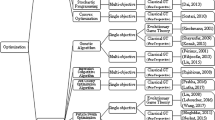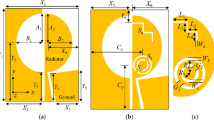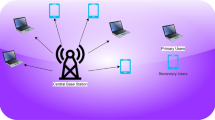Abstract
Optimal resource management in a cognitive radio network has been studied using the game theory. Based on personal interests, users select their own desired utility function and compete for channel and power selection. This non-cooperative approach is controlled through an appropriate pricing method. We have shown that if the utility function in a cooperative potential game is used as the pricing function in a non-cooperative network, the game governing the non-cooperative network will also become potential and will thus converge to Nash equilibrium. The existence of selfish users will cause the network to be unstable, the one which has presumptively been designed with users’ cooperation. Besides, it decreases resource utilization gain. Using the recommended pricing has been shown to equilibrate the network. The equilibrium points also enjoy some optimality criteria such as Pareto optimality. By conducting simulations and studying parameters like sum-rate of network and its total interference, it is shown that resource utilization will also approaches to optimal states.









Similar content being viewed by others
References
Felegyhazi, M., Cagalj, M., Bidokhti, S.S., Hubaux, J.-P. (2007). Non-cooperative multi-radio channel allocation in wireless networks. In Proceedings of IEEE INFOCOM (pp. 1442–1450).
Manshaei, M.H., Félegyházi, M., Freudiger, J., Hubaux, J., Marbach, P. (2007). Spectrum sharing games of network operators and cognitive radios. In F. H. P. Fitzek & M. D. Katz (Eds.), Cognitive wireless networks. New York: Springer.
Buddhikut, M.M. (2007). Understanding dynamic spectrum access: Models, taxonomy and challenges. In 2nd IEEE international symposium on new frontiers in dynamic spectrum access networks (pp. 649–663).
Lehr, W., Crowcroft, J. (2005). Managing shared access to a spectrum commons. In 1st symposium on new frontiers in dynamic spectrum access networks (pp. 420–444).
Nie, N., & Comaniciu, C. (2006). Adaptive channel allocation spectrum etiquette for cognitive radio networks. Mobile Networks and Applications, 11, 779–797.
Canales, M., & Gallego, J. R. (2010). Potential game for joint channel and power allocation in cognitive radio networks. IET Electronics Letters, 46(24), 1632–1634.
Mwangoka, J., Letaief, K., & Cao, Z. (2009). Joint power control and spectrum allocation for cognitive radio networks via pricing. Physical Communication, 2, 103–115.
Saraydar, C. U., & Mandayam, N. B. (2002). Efficient power control via pricing in wireless data networks. IEEE Transactions on Communications, 500, 291–303.
Wang, F., Krunz, M., & Cui, S. (2008). Price-based spectrum management in cognitive radio networks. IEEE Journal of Selected Topics in Signal Processing, 2(1), 74–87.
Kollimarala, B., Cheng, Q. (2010). Adaptive pricing for efficient spectrum sharing in MIMO systems. In IEEE 71st Conference on Vehicular Technology (VTC 2010-Spring) (pp. 1–5).
Huang, J., Berry, R. A., & Honig, M. L. (2006). Distributed interference compensation for wireless networks. IEEE Journal of Selected Topics in Communications, 24(5), 1074–1084.
Neel, J.O. (2006). Analysis and design of cognitive radio networks and distributed radio resource management algorithms. PhD thesis, Blaksburg, VA. http://www.omidi.iut.ac.ir/SDR/2007/WebPages/07_GameTheory/Neel_diss.pdf
Neel, J. O., Reed, J. H., & Gills, R. P. (2004). Convergence of cognitive radio networks. Wireless Communications and Networking Conference, IEEE, 4, 2250–2255.
Wang, B., Wu, Y., & Ray Liu, K. J. (2010). Game theory for cognitive radio networks: An overview. Computer Networks, 54, 2537–2561.
Hossain, E., Niyato, D., & Han, Z. (2009). Dynamic spectrum access and management in cognitive radio networks (pp. 237–240). Cambridge: Cambridge University Press.
Neel, J., Buehrer, R., Reed, J., Gilles, R. (2002). Game theoretic analysis of a network of cognitive radios. In IEEE midwest symposium on circuits and systems (Vol. 3, pp. III-409–III-412).
Neel, J., Reed, J., Gilles, R. (2002). The role of game theory in the analysis of software radio networks. In SDR forum technical conference
Grokop, L., Tse, D. (2010). Spectrum sharing between wireless networks. In IEEE/ACM transactions on networking (Vol. 18, No. 5).
Chen, C. S., Shum, K. W., & Sung, C. W. (2011). Round-robin power control for the weighted sum rate maximisation of wireless networks over multiple interfering links. European Transactions on Telecommunication, 22, 458–470.
Alrabaee. S., Agarwal. A., Geol, N., Zaman, M. (2012). Comparison of spectrum management without game theory (SMWG) and with game theory (SMG) for network performance in cognitive radio network. In 2012 Seventh international conference on broadband, wireless computing, communication and applications (BWCCA) (pp. 348–355).
Yi, Y., & Chiang, M. (2008). Stochastic network utility maximization- a tribute to Kelly’s paper published in this journal a decade ago. European Transactions on Telecommunication, 4, 421–442.
Author information
Authors and Affiliations
Corresponding author
Appendix
Appendix
In order to proof the convergence of such a game, number terms and theorems need to be introduced.
Definition 1 (path)
A path in G is a finite or infinite sequence of \( \varphi = \left( {{\mathbf{s}}^{1} ,{\mathbf{s}}^{2} , \ldots ,{\mathbf{s}}^{\varvec{l}} , \ldots } \right) \) such that for every l ≥ 1 there exists a unique deviator the number of which is the index of the only column differ between \( {\mathbf{s}}^{\varvec{l}} \) and \( {\mathbf{s}}^{{\varvec{l} + 1}} \).
Based on its definition, followings can be taken as granted about a path:
-
Only unilateral deviations are permitted in a path.
-
Multilateral paths can be introduced as a broader class of paths in which s k and s k+1 can differ in multiple columns.
Definition 2 (improvement path)
An Improvement Path is a path in which following holds: \( \forall k \ge 1, u_{i} \left( {{\mathbf{s}}^{{{\mathbf{k}} + 1}} } \right) > u_{i} \left( {{\mathbf{s}}^{{\mathbf{k}}} } \right) \) Where i is the unique deviator in kth step. Based on the above definition, players are assumed to play rational in an Improvement Path.
Definition 3 (finite improvement property (FIP))
Game \( G = \left( {N,\varvec{S},\left\{ {u_{i} } \right\}} \right) \) is said to have the FIP if all improvement paths in it are finite.
Definition 4 (cycle)
A cycle is a finite path of \( c = \left( {{\mathbf{s}}^{1} ,{\mathbf{s}}^{2} , \ldots ,{\mathbf{s}}^{\varvec{l}} } \right) \) in which, \( {\mathbf{s}}^{1} = {\mathbf{s}}^{\varvec{l}} \). This cycle is called an improvement cycle if c is an improvement path.
Considering mentioned definitions, Theorem 2 is brought out which proves the decisive convergence of Ordinal Potential games under certain circumstances and is a step ahead to prove the convergence of our network.
Theorem 2 (ordinal potential games have FIP)
As is mentioned in [12] having FIP in a finite game \( G = \left( {N,\varvec{S},\left\{ {u_{i} } \right\}} \right) \) is equivalent to not having improvement cycles in it, thus below is offered the proof of Ordinal Potential games having FIP:Consider an Improvement cycle of \( c = \left( {{\mathbf{s}}^{1} ,{\mathbf{s}}^{2} , \ldots ,{\mathbf{s}}^{\varvec{l}} } \right) \), in which:
Where i is the unique deviator in kth step. Occurring c in an Ordinal Potential game G *with v(·) as its potential function, results in:
That results in: \( v\left( {{\mathbf{s}}^{1} } \right) < v\left( {{\mathbf{s}}^{2} } \right) < \ldots < v\left( {{\mathbf{s}}^{\varvec{l}} } \right) = v\left( {{\mathbf{s}}^{1} } \right) \) which is not possible.Thus there exists no such c which, proving that all Ordinal Potential games have FIP.
1.1 Convergence
Being applied the Asynchronous timing rule and best response decision rule, a game having FIP is proved to enjoy convergence property [12]. For the introduced game, if the number of network users is sufficiently large, the probability of existence of two or more deviators in each step is negligible. Hence, the game is an ordinal potential one in which all the strategy sequences can be considered as improvement paths and we have proved that all such paths in an ordinal potential game are finite so the strategy sequences converge.
Rights and permissions
About this article
Cite this article
Mostaani, A., Sabahi, M.F. & Asadi, N. Obtaining a Potential Game Through Pricing, to Achieve Optimal Resource Management in Non-cooperative Cognitive Radio Networks. Wireless Pers Commun 87, 45–62 (2016). https://doi.org/10.1007/s11277-015-3025-7
Published:
Issue Date:
DOI: https://doi.org/10.1007/s11277-015-3025-7




